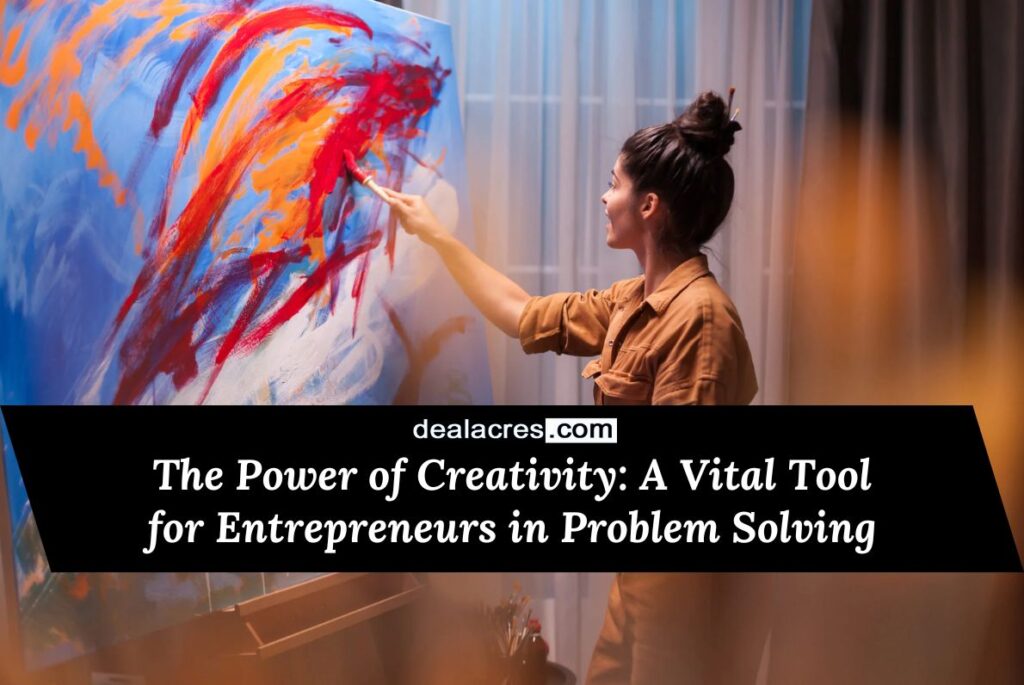Introduction:
In the world of entrepreneurship, problem-solving is like navigating a maze. Challenges and obstacles lurk around every corner, waiting to trip up even the most prepared business owner. However, there’s a secret weapon that successful entrepreneurs wield with finesse: creativity. In this article, we’ll explore the key role creativity plays in problem-solving for entrepreneurs and how fostering a creative mindset can lead to innovative solutions.

Understanding Creativity:
Before delving into its role in problem-solving, let’s first understand what creativity truly means. Creativity is not just about artistic expression or coming up with wild ideas. It’s about thinking outside the box, breaking free from conventional patterns, and generating novel solutions to problems. In essence, creativity is the fuel that drives innovation and propels businesses forward.
The Role of Creativity in Problem Solving:
Entrepreneurs encounter a myriad of challenges on their journey, from financial hurdles to operational inefficiencies and market fluctuations. To navigate these challenges successfully, they must be adept problem solvers. This is where creativity shines brightest.
- Thinking Beyond Boundaries: Creativity encourages entrepreneurs to break free from conventional thinking patterns. Instead of approaching problems linearly, creative individuals explore unconventional avenues and consider possibilities that others might overlook. For example, when faced with a cash flow crunch, a creative entrepreneur might explore alternative financing options or devise innovative ways to generate revenue streams.
- Embracing Failure as a Stepping Stone: In the world of entrepreneurship, failure is inevitable. However, creative individuals view failure not as a roadblock but as a stepping stone to success. Each setback presents an opportunity to learn, adapt, and refine their approach. This resilience allows entrepreneurs to bounce back stronger and more innovative than before, turning setbacks into springboards for creativity.
- Encouraging Collaborative Problem Solving: Creativity thrives in collaborative environments where diverse perspectives intersect. By fostering a culture of collaboration within their teams, entrepreneurs can leverage the collective creativity of their employees to tackle complex problems. Through brainstorming sessions, ideation workshops, and open dialogue, diverse teams can uncover innovative solutions that one individual alone might not have conceived.
- Iterative Problem Solving: Creativity in problem-solving is not a one-time event but a continuous process of iteration and refinement. Entrepreneurs who embrace creativity understand that the first solution they come up with may not be the most optimal. By adopting an iterative approach, they test, tweak, and improve their solutions based on feedback and real-world outcomes, leading to more effective and sustainable results.

Practical Strategies to Foster Creativity in Problem Solving:
Now that we’ve established the importance of creativity in problem-solving, let’s explore some practical strategies that entrepreneurs can implement to foster a creative mindset within their organizations.
- Create a Safe Space for Creativity: Entrepreneurs should cultivate an environment where employees feel empowered to express their ideas without fear of judgment. Encourage risk-taking and experimentation, and celebrate both successes and failures as learning opportunities. By fostering a culture of psychological safety, entrepreneurs can unlock the full creative potential of their teams.
- Provide Time for Reflection and Exploration: In the fast-paced world of business, it’s easy to get caught up in the daily grind and neglect the creative process. Entrepreneurs should carve out dedicated time for reflection and exploration, allowing themselves and their teams to step back from day-to-day tasks and think critically about the challenges they face. Whether it’s scheduling brainstorming sessions or implementing “creative Fridays,” prioritizing time for creativity can lead to breakthrough solutions.
- Diversify Perspectives: Creativity thrives on diversity. Encourage the formation of cross-functional teams comprising individuals with diverse backgrounds, skill sets, and perspectives. By bringing together people with different ways of thinking, entrepreneurs can foster creative collisions that spark innovation. Additionally, seeking input from customers, partners, and other stakeholders can provide fresh insights and inspire novel solutions.
- Embrace Constraints: Contrary to popular belief, constraints can fuel creativity rather than stifle it. By embracing limitations such as budgetary constraints, resource shortages, or time pressures, entrepreneurs can stimulate creative thinking and encourage innovative problem-solving. Constraints force individuals to think creatively within the parameters they’re given, leading to resourceful and inventive solutions.

Conclusion:
In the dynamic landscape of entrepreneurship, problem-solving is not merely a skill but a mindset. By harnessing the power of creativity, entrepreneurs can tackle challenges head-on, turning obstacles into opportunities and setbacks into successes. From thinking beyond boundaries to embracing failure as a catalyst for growth, creativity permeates every aspect of the entrepreneurial journey. By fostering a culture of creativity within their organizations and implementing practical strategies to nurture innovation, entrepreneurs can unlock their full potential and pave the way for transformative change in the business world. So, embrace your creativity, and let it guide you on the path to entrepreneurial success.




